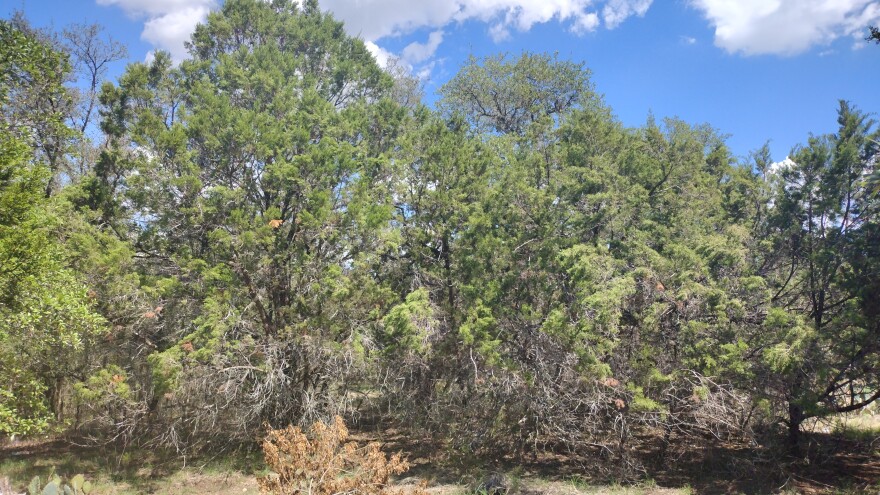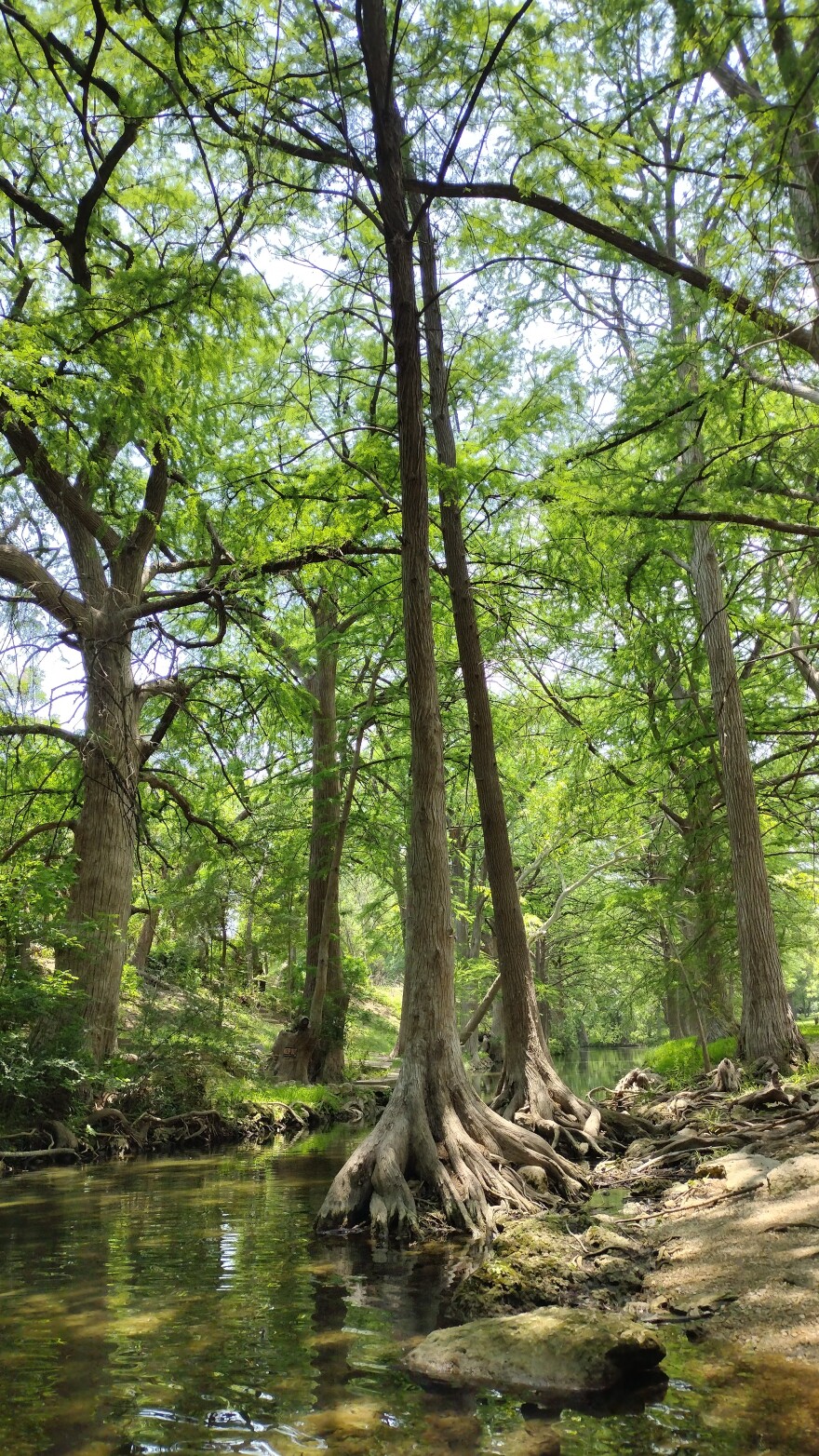Plants native to Central and South Texas are smart. They’ve evolved to the boom-and-bust cycle of water typical to our area. It’s natural for vegetation to get yellow and crispy during hot, dry periods such as this current drought.
However, woodland ecologist Karl Flocke of the Texas A&M Forest Service is noticing something different about plants’ response to this year’s drought. TPR contributor Daniel Ramirez spoke with him about how Texas plants have adapted to be drought resilient and what he’s observed about this current drought.

Daniel Ramirez: So, we're in drought this year. And I think a lot of people, when they drive around the countryside, they see the yellow, crispy grass and they probably think, ‘Oh, everything's dead.’ Can you explain a little bit about what is actually happening with plants when they look like that around here?
Karl Flocke: Plants have a number of different adaptations to drought, to lack of moisture and, of course, the extreme heat that we experience usually with it. Depending on how they grow, they might respond differently.
Grasses typically grow on a perennial basis here, meaning that they will grow from the same rootstock every year, putting up new vegetation. And so when they experience extreme heat and drought like this, very often they will simply cut off water flow to that new vegetation and wait out the drought. The roots are still alive, but maybe what is above ground is brown and crispy.
Trees will do a similar strategy sometimes in which they will start to drop off their leaves. Leaves will turn yellow, they'll droop, and some trees can completely shut off that water flow to the leaves and go into a state of dormancy where the tree is still alive, but everything above ground appears to be dead.
There's a lot that can be said for when everything looks brown and crispy. There is still life out there. It might just be waiting for that next rain.
DR: What are some other strategies that plants in our area have to adapt to drought and be resilient?
KF: You very often see short statured plants with smaller leaves. You think about the trees here compared to trees in the southeastern United States or the Pacific Northwest, and those are giant tall trees with big leaves usually, while the ones here look kind of short and stunted. And that helps to conserve water.
We also see trees that put down deeper roots trying to access water lower down in the ground once things start to dry out. Good examples of that are mesquite trees as well as live oaks.
Then we also see an actual physiological difference in the structure of the tree, a resistance to something called cavitation. Cavitation is the actual process that kills the tree during a period of drought in which air bubbles will form within the xylem, which is the water conducting tissue of the tree. If those air bubbles get into the xylem because the water pressure is too low to withstand them, water can't flow through the tree anymore, and the tree will die. And so we have trees that are really good at resisting that process. An example of that is Ashe Juniper, which can survive at very low water pressure levels.

DR: Can you talk about the role of the plants' stomata in retaining moisture?
KF: So the way plants operate is they, of course, take water from the ground. They bring it up to their leaves. And in their leaves, they use that water for photosynthesis to make sugars and everything the plant needs to survive.
Part of that is in the leaf. There are cells called stomata which open up and let in carbon dioxide from the atmosphere. In doing that, they release a lot of water. And so an adaptation we see lots of times in periods of drought or in drought prone regions like Central Texas is you'll see smaller stomata on the leaves or more effective guard cells that help to essentially keep water in the leaf, keep it from escaping.
That is the process really in which trees lose water to drought. But it's also an adaptation that helps them to survive in drier areas. And that's one of the reasons why some trees will have or some plants in general will have dormancy as a process is because that helps to limit that water loss through photosynthesis.
DR: It seems like you are seeing something a little different with this year's drought as far as plants’ ability to adapt. Can you explain to us what a riparian area is and what you're noticing in those areas?
KF: We do see kind of a difference between trees that grow in what we would call upland sites – those are the sites on hills, say, that are typically much drier environments in general – and trees in what we consider to be riparian areas, places like creeks, rivers, springs really anywhere adjacent to water. Those trees have grown in an area where they are typically always able to access water. They have not had to acclimate to lower water supplies, and very often they require more water in general. They're bigger trees, they've got bigger leaves. That's just how they grow.
But what we see is in many of the droughts recently, the effects of low precipitation are exacerbated by the fact that we, of course, are drawing groundwater supplies for our use. Drawing down groundwater supplies can reduce flow in springs, which ultimately provide water for a lot of our creeks and rivers. And so that can reduce the water that those trees have become accustomed to and need to grow.
The greatest effects of a drought are very often seen in those riparian areas. A lot of the trees as you drive around that you see turning brown are oftentimes in those areas close to creeks, tanks, areas where we normally have lots of water.

DR: Has fire played any kind of role this year as far as how plants are doing?
KF: Fire does play a role during drought. We've been fairly lucky in Central Texas this year. We have not seen the widespread fire that we saw, say, in the drought of 2011, but it certainly has been present here.
What we see is fire and drought go hand-in-hand as the moisture content within trees decreases. As those grasses begin to turn brown, fire can spread very easily on the landscape. So it becomes a pretty major concern for humans during periods of drought because of course we have a lot of values at risk that can be destroyed by fire.
But it's also important to remember that both drought and fire are really natural processes here in Central Texas, and they are something that we would have historically seen. And it's something that even with all of our modern technology and ability to fight fire, we will continue to see drought and fire acting on the landscape as a natural process really.

DR: And don't live oaks have their own unique adaptation for responding to fire?
KF: Oak trees in general are very good at resprouting following a fire. They have a strategy, and it's also a good adaptation for drought, where the top of the tree can be killed back but the roots remain alive. And so following a fire or even following extreme drought, very often we'll see trees die on the landscape, but in the following years we'll see sprouts come up from the ground and new trees begin to replace them growing from the same root system.
Live Oaks can grow in clonal colonies where, essentially, once upon a time an acorn fell, a tree started to grow and all the trees now you're seeing emerging in that group could be coming from the same root system. They are effectively clones of each other. They are the same tree, just different trunks.


